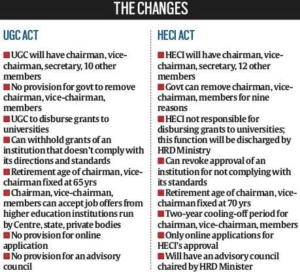Facilitating degrees within a degree.
Relevance
- GS Paper – 2 Education, Human Resource, Centre-State Relations.
- Tags:#UGC, #National Higher Education Qualifications Framework.
Why in the news?
Even though the movement to specify frameworks for higher education qualifications had gained momentum across the world in the late 1990s, India remained without a National Higher Education Qualifications Framework (NHEQF) until recently.
The idea was deliberated at the 60th meeting of the Central Advisory Board of Education in 2012, which assigned the responsibility to the University Grants Commission (UGC).
The problem of plenty
- Globally, higher education qualification frameworks include details of the definition and requirements of credits.
- The UGC has chosen to prescribe two separate frameworks — the NHEQF and the National Credit Framework.
- Higher educational institutions are separately required to implement the Academic Bank of Credits as a mandated modality for recognizing, accepting, and transferring credits across courses and institutions.
- Additionally, there are many other regulations that impinge on higher education qualifications.
- All of these could have been integrated into the NHEQF. This defeats the purpose of prescribing a qualification framework. After all, a qualification framework must minimize ambiguities in comprehending qualifications in a cross-cultural context.
Significance
- By definition, a national higher education qualification must encompass all disciplines and must clearly provide for the eligibility conditions for the entry into, and completion of, all programmes of studies.
- The NHEQF does provide exit requirements, but eligibility conditions and pathways through which a student can enter a programme at a particular level are alluded to vaguely.
- Besides, higher education qualifications awarded by disciplines such as agriculture, law, medicine, and pharmacy are conspicuous by their absence.
- The higher education system in India is far more diverse and complex than the European Higher Education Area.
- It warrants much wider and more intense consultations with the States. Doing this could have substantially enriched the NHEQF.
- The process of formulating the NHEQF should have duly recognized the sheer size of the higher education system and the variations in it, as well as the federal structure, constitutional provisions that put education on the Concurrent List, and the fact that States spend a lot more on education than the Centre.
Difficulties in implementation
- At a practical level, there might be some serious difficulties in implementing the NHEQF.
- The document places all higher education qualifications on a continuum of 4.5 to 10. The framework equates postgraduate diplomas with four-year undergraduate programmes.
- This poses a problem in determining the level of such undergraduate degrees that are pursued after another undergraduate degree, like B.Ed. Further, the idea that a B.Ed could be completed in one, two or four years is confusing.
- The credit framework document of the UGC mandates that each semester must have a minimum of 20 credits.
- This document suggests that one credit must comprise 15 hours of direct and 30 hours of indirect teaching.
- This means that students are required to study for a minimum of 900 hours per semester or close to 10 hours a day. This is ambitious even for fully residential higher educational institutions.
- Higher educational institutions with minimal infrastructure and meagre faculty resources may find this daunting.
Conclusion
The mystery of the learning outcomes borrowed liberally from the Dublin descriptors remains unaddressed. Whether generic or specific to a discipline, learning outcomes may vary significantly across disciplines. Besides, they may not be measurable by the same yardstick across disciplines.
Source: The Hindu.
Mains Question
Discuss the main objectives of Population Education and point out the measures to achieve them in India in detail.





